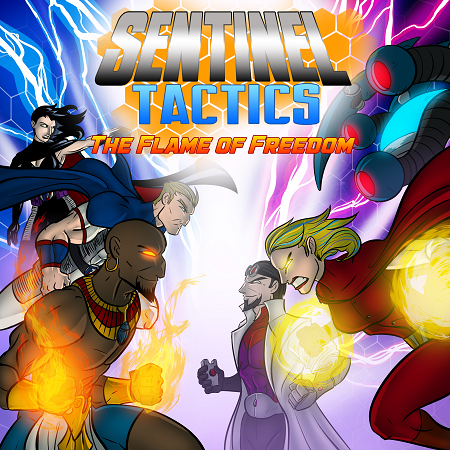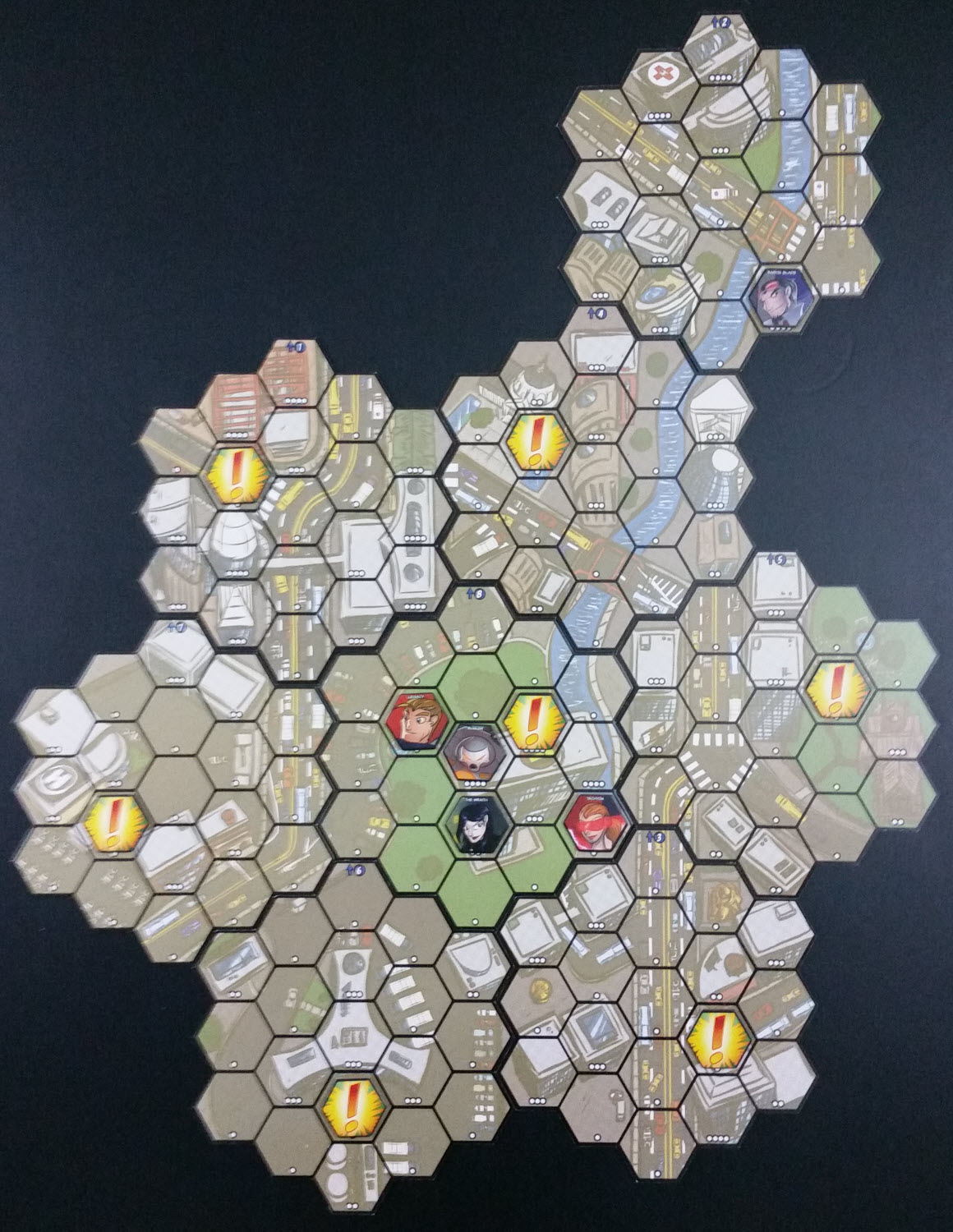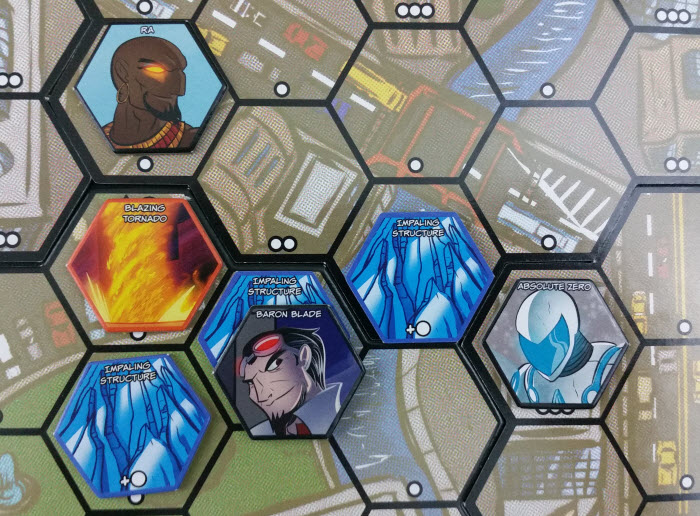You anticipated the attack from within the building or a helicopter, but not from thin air. This thought goes through your mind as electricity audibly discharges in all directions and your feet give out under you. As your face meets the rooftop, you hear the snide snickering of a man you know all too well.
“Lying down on the job are we Tachyon?”, chimed Baron Blade. “I find that a bit shocking really.” More snickering. Your overwhelming desire to punch him in the face spurs you up.
“You aren’t taking the reactor Ivan.”
Giving him no time to think, you channel energy into your accelerated speed. You race behind him, square up, and pivot all that built up kinetic force into a devastating kick at the Baron’s backside…
Or, at least that was supposed to be what happened. Instead, all you see is a flash of light and finding yourself reeling on the ground once again.
Baron Blade leans over, head slightly tilted as if curious at the outcome. “Repulsor field, my dear. I wouldn’t have stopped to catch up if I was actually worried you could stop me. But I do have to run. Deadlines and all. Toodles!”
The sound of your cursing is drowned out as Baron Blade teleports away with his prize.
The Premise
In the superhero world, not even heroes get along all the time. Playing out like comic book serials of ever-shifting loyalties, each player takes on the role of various super-powered heroes or villains. Teams of players are then pitted against the villain player…or against another team of fellow heroes. And only one side can remain standing.
The Rules
As the name implies, Sentinel Tactics is a team-based tactical fighting game that’s played out on an interchangeable hex map. The game comes with copious tokens, markers, dice, and cards, but only a portion are used during any single playthrough. Tactics can be played in a handful of variations, including a basic skirmish mode or using one of many Scenarios. Consequently, the level of setup time will vary.
Each game begins similarly, however. First, players decide on the style of game to play. While skirmish conditions are largely at the discretion of the players, Scenarios lay out the game’s requirements, such as which side of the hex boards to use (the urban Megalopolis or the jungle-heavy Insula Primalis), the makeup of the teams, special Scenario rules, win conditions, etc. In the first Scenario, for example, one player must be the villainous Baron Blade while 1-3 other players choose a hero character.
Every character in Sentinel Tactics comes with a token, character board, and a small deck of unique Power cards. Characters possess a number of traits, including their health, the number of available actions each turn, their defense, and the number of dice used to determine their movement.
Each character also has a unique set of powers. Some powers are passive, while others require an action to use. Powers on a character’s board are always available, but players gain additional powers through Power cards. At the start of the game, players choose two Power cards to use.
Games of Sentinel Tactics are played out in a series of rounds. Unless outlined differently by a Scenario, turn order is determined randomly, with players from each team alternating. Turns are broken down into four phases: Power Up, Surge, Go Time!, and To Be Continued.
During Power Up the player may swap one of their Power cards with another card from their hand. Next, anything that trigger during the Surge phase does so. Then comes Go Time!, which is where most of Sentinel Tactics takes place. In Go Time!, players take their actions. Actions mostly consist of four basic options (Move, Sprint, Aim, or Dodge), plus attacks.
Assuming an opponent is within Line Of Sight, the player can attack. Both attack range and movement points are also affected by differences in elevation, as depicted on the hexes. Most attacks and every defense roll involves rolling a number of dice, applying bonuses, and removing all of that attack’s failures. If any attack die exceeds the range between the two units, those dice hit. Each defense die whose result meets or exceeds an attack die stops it; any attack dice that get through result in the player losing that much health. If a player loses all of their health they become Incapacitated, resetting their character to starting conditions and limiting them to one Power card their next turn.
Once all actions are taken, their turn ends with To Be Continued. Here, the player rolls dice to determine their movement points for their next turn.
After each player has taken their turn, a new round begins. Players continue moving and attacking in this manner until one side achieves the victory condition outlined in the Scenario, or until one team reaches an agreed-upon number of Incapacitations for a skirmish.
The losing team will likely immediately begin planning their long and convoluted revenge. Because comic books.
Fighting With Style
Many combat-laden strategy games have a tendency to be shallow on flavor and purpose, opting for a purely mechanical exercise in hex-based head smashing. Sentinel Tactics does the opposite, tapping into a thematically rich background. From the different ways characters behave to the artwork of the cards, the game does an admirable job worldbuilding while not sacrificing complexity.
With the exception of a couple thematic quandaries, Tactics blends theme and mechanics nearly seamlessly. The Scenarios are especially well done in this sense, each behaving differently while providing a light story-driven reason as to why you want to pummel your enemies – so much so that even Immersionists can enjoy this tactics-heavy experience. The only thing that’s seemingly missing is a 3D map. Or a bat signal.
Skirmishes are an even more free-form approach, letting players make up their own scenarios to play out. Tech-based heroes versus superpowered ones running around Megalopolis? You can do that. Melee versus ranged fighters scurrying around the island volcano’s brush cover? You can do that too. Fending off the bad guys while the center of Megalopolis erupts into a burgeoning volcano? Totally possible.
In keeping with the game’s comic book style thematics, players are free to conceive all manner of possibilities, from the most outlandish setups to spartan arcade-fighting style deathmatches. Sentinel Tactics comes with a plethora of tokens and environmental variables, and it’s not difficult to re-purpose Scenario cards for your own ends, providing an incredible amount of variability and versatility. As a result, the game’s level of replayability is impressive, especially given that its core mechanics simply involve moving and trying to hit things.
Baron Blade Runner
Stripping away the power gauntlets and spandex suits, it’s evident that conflict lies at the heart of Sentinel Tactics. The game doesn’t shy away from this fact – it revels in it. However, for a game that desires streamlined combat on the one hand and deep strategy on the other, the results of quickly immersing you into an easy-to-follow combat system are decidedly mixed.
Firmly in its favor are the game’s characters. Tactics comes with nine playable heroes and villains, each providing a wholly individual experience. Not only does every character have a unique set of powers that invite strategic decision-making, but every one of those powers reflect the character. Sentinel Tactics melds flavor with mechanics in such cogent way that you actually feel as if you’re that character in battle.
What’s more remarkable is how balanced these characters are – even with all of their disparate abilities and fighting styles. While some characters may pair up better against one another individually, the game’s overall fights maintain a decent amount of party. Every character has the opportunity to turn the tide of battle and be a valued member of their team.
Ironically, the game’s adherence to character identity also makes Sentinel Tactics harder to learn. This is because while there’s flexibility over how you can use each character, you can’t get them to play against their nature. Daredevils won’t enjoy this fact, but given the bounty of tactical risk-taking opportunities the game otherwise affords you, they’ll still be right at home in this environment. To truly be effective you need to understand your character – which can be tricky since it’s not explicitly stated anywhere.
In the same vein, given how much time players spend in conflict, and it being the most likely area to make mistakes, it’s strange that Sentinel Tactics lacks player reference sheets for the multi-step attack and defense process. Sentinel Tactics aims for combat to be simple and fluid, but between the calculations of range, elevation, line of sight, and bonus tokens, combat isn’t actually as intuitive as it’s made out to be.
That being said, the only true detraction with the game’s mechanics rests with character movement. Having movement be one step above the classic Roll And Move approach can be quite frustrating – especially in the thick of a tense battle. In a game that does such a praise-worthy job in keeping with flavorful mechanics, the idea of a semi-random movement system makes little thematic sense. Does a poor roll mean Legacy just decided to take a nap?
While a couple of these factors will give them momentary pause, none of it will be enough to deter Tacticians from embracing the calculating interplay permeating every aspect of the game. This is their type of strategy game – particularly when using Scenarios. Given that Sentinel Tactics is almost exclusively about the thrill of chasing down your enemies as you try to be the last team standing, Strikers should also enjoy this game, though their enthusiasm will be more tempered.
On the other hand, the level of involvement and focus necessary in this game will be too much for Socializers. Moreover, because Sentinel Tactics focuses almost exclusively on strategically knocking your opponents unconscious (barring the occasional Scenario mission), don’t expect progression-loving Architects to be strapping on a cape anytime soon either.
The Incomplete Road Map
Unfortunately, all of this freedom comes at the expense of clarity. While the basic tenants of Sentinel Tactics are simple to understand once taught, the game has a notable learning curve. Part of this is the volume of material it provides, but much of the learning curve is also artificial, a result of the way the rules are organized.
Sentinel Tactics intends you to dive into the Scenario books since they’re the ones that specify the various board setups and victory conditions. Yet, the main rulebook omits these pieces of information, which can be disorienting.
For instance, the rulebook doesn’t have a designated section for starting player materials, nor does it cover things like how you distribute turn order markers. Tactical games with lots of abilities – especially with the use of line of sight mechanics – are bound to have instances not covered in the base rules, but many here are either vague or must be inferred, making it easy to overlook some of the game’s fundamental facets.
What’s more, the rules for skirmish games are largely open-ended and undefined. Yet rather than have players begin with a simple skirmish or starter Scenario, the first Scenario in Sentinel Tactics is an asymmetrical map where you can have upwards of three players against one.
Therefore, although the rules are not difficult to read and do provide decent examples on the more difficult aspects of the game, their layout is not as ideal as they could be. The rules as printed are easily the game’s biggest detraction, and it has a ripple effect throughout the entire game experience. It’s hard enough to remember all the secondary nuances in Sentinel Tactics; one shouldn’t need to keep referencing the basics.
The Takeaway
Sentinel Tactics does a masterful job mixing strategic hex-based fighting with a resonant theme, ensuring that whether you’re playing one of its numerous Scenarios or a creatively-crafted skirmish game, it will not easily run dry of replay options. With wholly original fighters and team-based combat, Sentinel Tactics has the innate ability for every game to end with a story to tell. Indeed, the game’s only real obstacle is itself. With a notable learning curve and a ruleset that doesn’t do itself any favors by having several scattered or inferred rules, the game doesn’t quite live up to being as easily accessible as it would like. That said, when done right, Sentinel Tactics plays out like a taut comic book, with each page full of daring confrontations and narrow escapes. For those who enjoy strategy-heavy fighting and spandex, this is one game that will not usually leave you hanging.
Sentinel Tactics is a product of Greater Than Games.
Cardboard Republic Snapshot Scoring (Based on scale of 5):
Artwork: 4
Rules Clarity: 3
Replay Value: 4.5
Physical Quality: 3.5
Overall Score: 4
Photo Credits: Volcano by 20th Century Fox.


